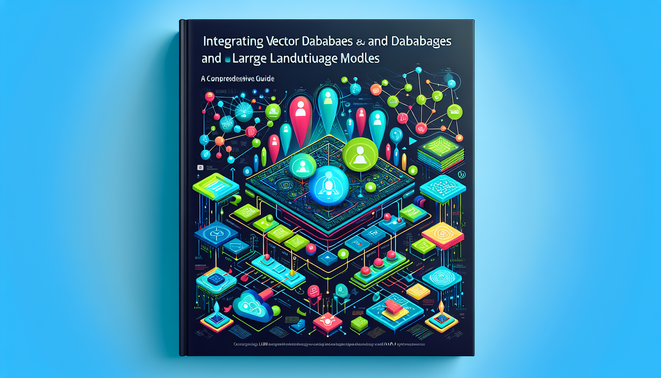Physical Address
304 North Cardinal St.
Dorchester Center, MA 02124
Physical Address
304 North Cardinal St.
Dorchester Center, MA 02124

Integrating Vector Databases and Large Language Models: A Comprehensive Guide
Meta Summary: Discover how integrating vector databases with large language models (LLMs) can revolutionize AI applications. This guide provides a detailed exploration of scalable architectures, optimization strategies, and real-world case studies, while also offering operational and future insights.
Introduction to Vector Databases and LLMs
Vector Databases and LLMs in Modern AI
Vector databases and LLMs are pivotal in current AI applications. Vector databases efficiently manage high-dimensional vector embeddings, essential for similarity searches. LLMs, in contrast, excel in generating human-like text suitable for tasks such as chatbots and content generation.
Technical Breakdown
A vector database specializes in the efficient storage and retrieval of vector embeddings—mathematical data representations critical for similarity searches and analytics. They are core to applications demanding rapid and accurate data access.
Large Language Models (LLMs) are AI models that process and generate natural language. Trained on extensive text datasets, they utilize deep learning to predict subsequent words in a sentence, supporting roles like language translation and summarization.
Tip: Understanding the core functionalities of vector databases and LLMs is fundamental to leveraging these technologies effectively.
Architecture Overview for Scalable Integration
Building Efficient, Scalable Systems
Developing scalable integration architectures involves meticulous planning of vector databases and LLMs. Prioritizing cloud deployment strategies allows systems to scale efficiently, managing increased loads without degrading performance.
Technical Explanation
Implementing a scalable architecture demands a microservices approach, permitting different system parts to scale independently:
Vector Database Layer: Manages storing and retrieving vector embeddings.
LLM Layer: Processes text and relies on the vector database for data retrieval.
APIs and Microservices: Ensure seamless component communication and allow modular scaling.
Note: Microservices enhance flexibility by isolating functions, offering targeted scalability, and fault containment.
Optimizing Inference Speed and Cost
Boosting Performance and Reducing Costs
Optimizing inference speed and cost is critical for enhancing AI system performance. Strategic caching and load balancing can dramatically reduce latency and optimize expenditure.
Technical Insight
Inference involves utilizing a trained model to predict on new data. To minimize latency (the delay from input to response):
Implement Caching: Cache frequent queries to quicken processing.
Utilize Load Balancing: Disperse requests across instances to avoid overload.
Conduct Cost Analyses: Weigh performance against resource utilization to inform strategic decisions.
Tip: Regular system performance assessments can provide clear insight into potential optimization areas.
Operational Best Practices
Ensuring Seamless Operations
Effective operational management underpins robust system functionality, emphasizing DevOps principles for continuous improvement of deployment processes.
Technical Explanation
Embracing DevOps principles supports continuous integration and deployment:
Automate CI/CD Pipelines: Reduces manual intervention, mitigating errors.
Monitor and Log: Identifies performance lags and security vulnerabilities.
Manage Scalability: Scale systems cost-effectively to accommodate growth.
Note: Regular infrastructure updates prevent technological obsolescence and keep systems agile.
Real-world Case Studies
Practical Application Insights
Real-world applications illuminate the benefits and challenges of combining vector databases with LLMs.
Case Study Overview
A prominent tech company optimized a customer service chatbot by merging a vector database with an LLM. This integration led to:
A 50% reduction in response times
Lowered operational costs due to efficient query processing via vector databases and enhanced user interaction through LLM-driven natural language understanding.
Tip: Analyzing successful integrations can unearth strategies relevant to specific applications.
Conclusion and Future Trends
Future of AI Integration
AI inference’s future lies in advancing vector databases and LLMs. Trends point towards automation, scalability enhancements, and refined data processing techniques.
Emerging Trends
Expect development in:
Advanced Vector Indexing: To upscale retrieval speed and precision.
Enhanced Model Training: With diverse datasets to bolster performance.
IoT Integration: Extending AI applications beyond conventional computing frameworks.
Note: Staying informed about emerging trends ensures systems remain cutting-edge and competitive.
Visual Aids Suggestions
Flowchart: Data flow between LLMs and vector databases with annotations on key processes.
Infographic: Cost benefits of optimizing AI inference, including savings and performance improvements.
Key Takeaways
Vector databases and LLMs are vital for high-performance AI applications.
Scalable architectures and optimization strategies handle larger data loads efficiently and cost-effectively.
Real-world case studies offer practical insights into successful integrations.
Continual advancements in AI technologies will influence cloud computing landscapes.
Glossary
Vector Database: A database tailored for high-dimensional vector embedding management.
LLM: Large Language Model, an AI model adept at processing and generating human-like text.
Inference: Using a trained model to forecast new data.
Latency: Delay from command input to system response.
Knowledge Check
What are the key features of a vector database?
A) High-speed data retrieval
B) Storage of high-dimensional data
C) Both A and B
Explain how latency affects user experience in AI applications.
Short Answer: Latency impacts the response speed, thus affecting user satisfaction and system efficiency.
Further Reading
Understanding Vector Databases in AI
Optimizing LLM Inference
Cloud Infrastructure Best Practices
This guide equips you with the knowledge to integrate vector databases and LLMs effectively, optimizing them for scalable, efficient AI applications. By adhering to best practices and tracking emerging trends, you can ensure robust, future-proof cloud architectures.